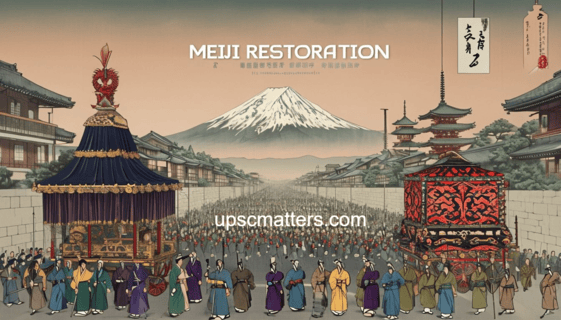What is Meiji Restoration ?
The Meiji Restoration in Japan(1868) marks a turning point in Japanese history, symbolizing the end of the feudal Tokugawa Shogunate and the restoration of imperial rule under Emperor Meiji.
This period (1868–1912) transformed Japan from a closed, agrarian society into a modern industrial state, setting the foundation for its emergence as a global power.
JAPAN BEFORE MEIJI RESTORATION

The pre-Meiji era, known as the Tokugawa or Edo Period (1603–1868), was characterized by feudalism, isolation, and cultural flourishing, which laid the foundation for the dramatic changes to come.
1.The Tokugawa Shogunate: The Feudal Framework.
During the Tokugawa period (1603-1868), Japan was ruled by the Tokugawa Shogunate, a military government established by Tokugawa Ieyasu. The emperor in Kyoto was largely a symbolic figure. While real political power rested with the shogunate in Edo (modern-day Tokyo).
WHAT IS SHOGUNATE ?

This feudal system was marked by:
•Class Hierarchy: Society was rigidly divided into four main classes: samurai, peasants, artisans, and merchants, with the samurai at the top.
•Daimyo and Domains: The country was divided into domains controlled by daimyo (feudal lords) who owed allegiance to the shogun but had significant autonomy in their territories.
•Sankin-kotai System: To maintain control over the daimyo, the shogunate required them to spend alternate years in Edo, effectively curbing their power and resources.

2. The Policy of Isolation: Sakoku
One of the defining features of the Edo period was the policy of sakoku (closed country), implemented in the 1630s. This policy restricted foreign trade and interaction to a few designated ports and tightly controlled access. For over two centuries:
•Limited Foreign Relations: Only the Dutch and Chinese were permitted to trade, primarily through the port of Nagasaki.
•Christianity Suppressed: The government banned Christianity, viewing it as a threat to social order and shogunal authority.
•Isolation’s Impact: While isolation preserved Japanese culture and prevented colonization, it also stunted technological and industrial progress compared to Western nations.
3. Economic Growth and Challenges
Despite isolation, Japan experienced significant economic development during this era. Urban centers like Edo, Osaka, and Kyoto flourished as hubs of commerce and culture.
•Agricultural Advances: Improvements in farming techniques led to population growth and increased agricultural surplus.
•Rise of the Merchant Class: Merchants, though low in the social hierarchy, accumulated wealth and power, leading to economic disparities and dissatisfaction.
•Economic Stagnation: By the late Tokugawa period, financial mismanagement and natural disasters created economic crises, straining both peasants and the ruling samurai class.
4. Cultural Flourishing
The Edo period was also a time of remarkable cultural achievements, often referred to as the “Golden Age” of traditional Japanese arts.
•Kabuki and Ukiyo-e: Kabuki theater and ukiyo-e woodblock prints became immensely popular, reflecting the tastes of urban commoners.
•Haiku and Literature: Poets like Matsuo Basho refined the art of haiku, while literary works captured the spirit of the times.
•Zen and Tea Culture: Traditional practices like Zen Buddhism and the tea ceremony flourished, emphasizing simplicity and harmony.
5. Challenges to the Shogunate
By the mid-19th century, the Tokugawa Shogunate faced growing internal and external pressures.
•Internal Dissent: Economic hardship led to peasant revolts, and disillusioned
samurai sought change.
•Western Intrusion: The arrival of Commodore Matthew Perry’s “Black Ships” in 1853 forced Japan to open its ports through the Treaty of Kanagawa in 1854. This humbling encounter with Western powers exposed Japan’s vulnerability.
•Call for Modernization: Reformist factions within Japan began advocating for modernization to resist foreign domination.
6. Prelude to the Meiji Restoration
The cracks in the Tokugawa system widened as a result of these challenges. Reform movements emerged, aiming to restore the emperor’s power and modernize Japan. The eventual collapse of the shogunate was precipitated by alliances between dissatisfied samurai and imperial loyalists, who sought to chart a new course for the nation.
Factors contributing to the emergence of the MR in Japan.
-
- Failure of the Shogunate:The Tokugawa Shogunate wasincapable of dealing with the country’s financial issues and could not resolve the political instabilitythat arose due to domestic rivalries. This undermined their authority, paving the way for change.
- Socioeconomic Discontent:The Tokugawa shogunate’s policies, such as strict socialhierarchy and isolation from the outside world, created socioeconomic disparities andstifled economic development. Dissatisfaction grew among peasants, merchants, and other marginalised groups, fuelling support for a new political order.
- Foreign Intervention: The arrival of Commodore Matthew Perry from the United States in 1853, demanding Japan to open up for trade, exposed the shogunate’s weakness in handling foreign pressures, stirring dissatisfaction among the populace and samurai class.
- Role of Satsuma and Chōshū: These powerful feudal domains harbored deep resentment against the Tokugawa shogunate. The Satsuma-Chōshū Alliance played a pivotal role in the overthrow of the shogunate, ushering in the Meiji Restoration.
- Samurai Discontent: Lower-ranking samurai were displeased with the Tokugawa system, which they felt served only the interests of high-ranking officials. They supported the emperor as an alternate power center and were instrumental in spearheading the Restoration.
- Sonnō Jōi Movement: This intellectual and social movement, translated as “Revere the Emperor, Expel the Barbarians”, advocated for the return of political power to the emperor and expulsion of foreign influence, directly contributing to the Meiji Restoration.
- Boshin War: This civil war (1868-1869)between forces loyal to the shogunate and those seeking its overthrow was the decisive military conflict that led to the end of the shogunate and the establishment of the Meiji era.
How Did MR Pave the Way for Japan’s Industrialization?
-
- Centralized Government: The Meiji Restoration replaced the feudal shogunate with a centralised government, which facilitated nationwide policies, making it easier to implement wide-scale reforms such as industrialization.
- Economic Reforms: The new government initiated several economic reforms. The Land Tax Reform of 1873, for instance, stabilised the government’s finances and encouraged cash-crop farming, providing the capital needed for industrialization.
- Foreign Experts and Study Abroad: Japan hired thousands of foreign advisors and sent students overseas to learn and import Western knowledge and technology, aiding the development of various industries, such as silk and cotton textiles, shipbuilding, and mining.
- Westernization and Cultural Transformation: The Meiji government actively encouraged the adoption of Western technologies, ideas, and cultural practices. Western-style dress, education, legal systems, and military practices. It also promoted the study of Western sciences, literature, and arts.
- State-led Industrialization: The Meiji government initially established and operated many industries itself, later selling them to private investors when they became profitable. This model reduced risks associated with new industries, encouraging private investment.
- Militarization: The government pursued Western-style military reforms, which necessitated an industrial base to produce modern armaments and ships. The establishment of Yawata Iron and Steel Works in 1901 to make weapons is a case in point.
- Meiji Constitution: The promulgation of the Meiji Constitution in 1889 established Japan as a modern nation-state. It set a clear legal framework for governance and secured domestic stability, thereby creating a conducive environment for industrialization.
Conclusion-
Overall, the Meiji Restoration transformed Japan from a feudal society into a rapidly industrializing and modern nation-state. It laid the groundwork for Japan’s rise as a major global power in the 20th century and set the stage for its subsequent economic and technological advancements.

